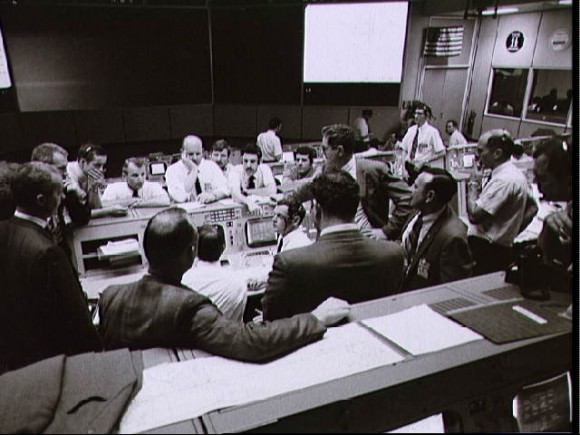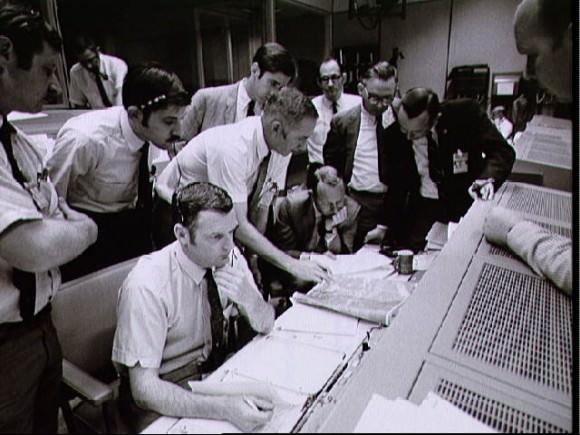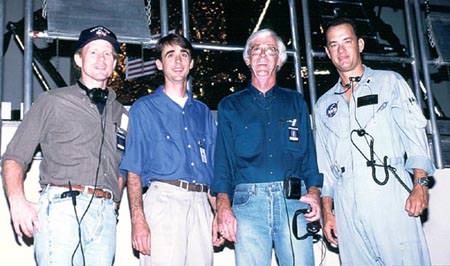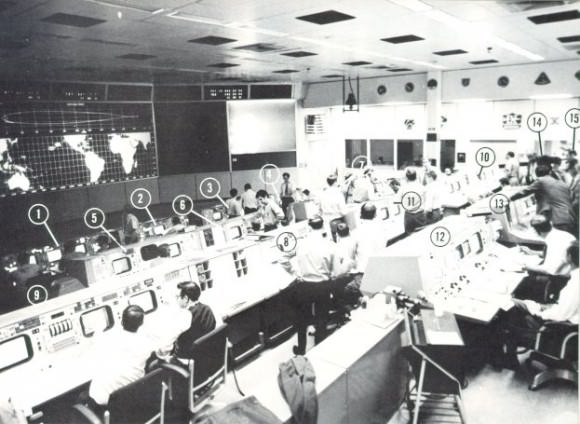To celebrate the 45th anniversary of the Apollo 13 mission, Universe Today is featuring “13 MORE Things That Saved Apollo 13,” discussing different turning points of the mission with NASA engineer Jerry Woodfill.
In the original Mission Operations Control Room (MOCR) at the Manned Spacecraft Center in Houston, a group of NASA flight controllers sat in the front row of the consoles, aligned nearest to the enormous front wall displays of the MOCR, or Mission Control. They sat in a ‘trench-like’ lower level with respect to the remaining flight controllers and this group came to be known as “The Trench.”
“The teamwork of the Apollo 13 band of Trench ‘brothers’ coordinating navigational challenges in a fashion that was never accomplished before or after in the annals of lunar flight was certainly one of the additional things that saved Apollo 13,” said NASA engineer Jerry Woodfill. “Failure to reach a consensus quickly in performance of the restoration of free return trajectory, the PC+2 and other crucial ‘burns’ would have been detrimental to rescue.”

Woodfill said that like the Parachute Infantry Regiment described in Stephen E. Ambrose’s popular book and subsequent mini-series “Band of Brothers” – which told of the teamwork and perils of combat during World War II — the men of The Trench served like a platoon of soldiers defending Apollo 13.
“It was a ‘fight for life,’ the lives of the Apollo 13 crew,” said Woodfill. “They were, indeed, defending the Apollo 13 crew from threatening guidance and trajectory adversaries.”
Jerry Bostick, who was among the leaders of that group for Apollo 13 agreed. He told this to PBS:
“We call the first row in the control center ‘the trench.’ There’s a debate about how it really got its name but it’s the lowest row of consoles in the control center and we called it ‘the first line of defense in manned space flight.’ We were the guys in the trench: the retro fire officer, the flight dynamics officer and the guidance officer. We were the ground pilots, if you will, who tracked the spacecraft, calculated the maneuvers and told the astronauts what time to burn, what maneuvers to do and where to go. So, we were a proud bunch.”
The Trench included the Guidance Officer called GUIDANCE or GUIDO, who monitored onboard navigational systems and guidance computer software and was responsible for determining the position of the spacecraft in space; the Flight Dynamics Officer (FIDO) who was responsible for the flight path of the spacecraft and so calculated orbital maneuvers and trajectories; and the Reentry Officer (RETRO) who was responsible for determining retrofire times for Trans Earth Injection (TEI) maneuvers to get the spacecraft back to Earth from the Moon, and calculated abort plans.
For Apollo 13, The Trench group’s members included Bostick, Dave Reed as lead FIDO, Chuck Dieterich, lead RETRO, along with John Llewellyn, Bill Stoval and several others who served during the Apollo lunar landing program.

“The most memorable among their kind was the famed lead flight director Glynn Lunney,” said Woodfill. “Glynn served as a father-like mentor of these men from the onset of the manned spaceflight program, beginning with the early days of Mercury at the Kennedy Space Center.”
Lunney has said this about The Trench, “We were a very small group in the huge enterprise of Apollo and we still feel like a ‘band of brothers’ who enjoyed a truly grand adventure.”
The Trench served to conceive, test, and execute many of the things we’ve discussed during the original “13 Things That Saved Apollo 13,” in 2010 as well as the additional thirteen things we’ve featured in 2015.
“Whenever maneuvers, engine firings, or reentry schemes of the Apollo 13 spacecraft are cited, the Trench-men were at work to save the crew from peril and even death,” said Woodfill.
Some members of this group have put together a fascinating collection of autobiographical accounts in a book “From the Trench of Mission Control to the Craters of the Moon.” Woodfill highly recommends the book for anyone wanting an exciting historic visitation into the history of the manned space flight program.
Incidentally, Woodfill notes that Jerry Bostick is the source of the famous Apollo 13 quote “Failure is not an option,” which Gene Kranz liked so much that he used it for the title of his own autobiography. Bostick gave this account to Woodfill:
As far as the expression ‘Failure is not an option”, you are correct that Kranz never used that term. In preparation for the movie, the script writers, Al Reinart and Bill Broyles, came down to Clear Lake to interview me on “What are the people in Mission Control really like?” One of their questions was “Weren’t there times when everybody, or at least a few people, just panicked?” My answer was “No, when bad things happened, we just calmly laid out all the options, and failure was not one of them. We never panicked, and we never gave up on finding a solution.” I immediately sensed that Bill Broyles wanted to leave and assumed that he was bored with the interview. Only months later did I learn that when they got in their car to leave, he started screaming, “That’s it! That’s the tag line for the whole movie, Failure is not an option. Now we just have to figure out who to have say it.” Of course, they gave it to the Kranz character, and the rest is history.

Also Jerry Bostick is indirectly responsible for the movie Apollo 13. His son Mike worked for Ron Howard as a producer at Universal Studios, and Mike, remembering his father’s time in the Apollo 13 trench, suggested Howard make a movie based on Apollo 13 Commander Jim Lovell’s book Lost Moon. Howard agreed it was a great idea.

Here’s the full list of all the flight controllers in this image: Key numbers above identify the locations of flight controllers. 1 was the Booster Systems Engineer, responsible for the three Saturn stages. 2 was the Retrofire Officer, keeping continuous track of abort and return-to-Earth options. 3 was the Flight Dynamics Officer, in charge of monitoring trajectories and planning major spacecraft maneuvers; he also managed onboard propulsion systems. 4 was the Guidance Officer, who watched over the CSM and LM computers and the abort guidance system. In the second row, 5 was the Flight Surgeon, keeping an eye on the condition of the flight crew. At 6 was the Spacecraft Communicator, an Astronaut and member of the support crew, who sent up the Flight Director’s instructions. (He was usually called CapCom, for Capsule Communicator, from Mercury days.) 7 concerned CSM and LM systems, including guidance and navigation hardware; and electrical, environmental, and communications systems. After Apollo 11, all communications systems were consolidated as a separate task. On the next row in the middle was 8, the Flight Director, the team leader. 9 was the Operations and Procedures Officer, who kept the team – in and out of the Center – working together in an integrated way. 10 was the Network Controller, who coordinated the worldwide communications links. 11 was the Flight Activities Officer, who kept track of flight crew activities in relationship to the mission’s time line. 12 was the Public Affairs Officer who served as the radio and TV voice of Mission Control. 13 was the Director of Flight Operations; 14 the Mission Director from NASA Headquarters; and 15 the Department of Defense representative. During activity on the lunar surface an Experiments Officer manned the console at 1 to direct scientific activities and relay word from the science team.
Previous articles in this series:
Part 1: The Failed Oxygen Quantity Sensor
Part 2: Simultaneous Presence of Kranz and Lunney at the Onset of the Rescue
Part 3: Detuning the Saturn V’s 3rd Stage Radio
Part 4: Early Entry into the Lander
Part 5: The CO2 Partial Pressure Sensor
Part 6: The Mysterious Longer-Than-Expected Communications Blackout
Part 7: Isolating the Surge Tank
Part 8: The Indestructible S-Band/Hi-Gain Antenna
Part 10: ‘MacGyvering’ with Everyday Items
Part 11: The Caution and Warning System
Find all the original “13 Things That Saved Apollo 13″ (published in 2010) at this link.


Another great article. I looked at the recommended book at Amazon but 999$ seems to be too much… I already have “The lost moon” and “Failure is not an option” in my library